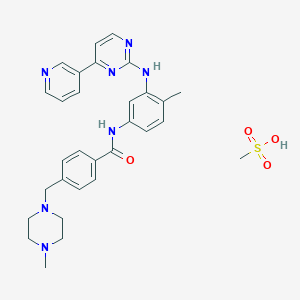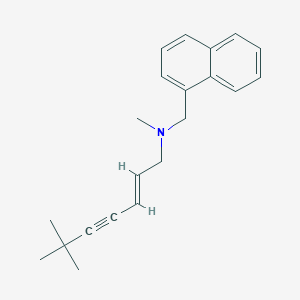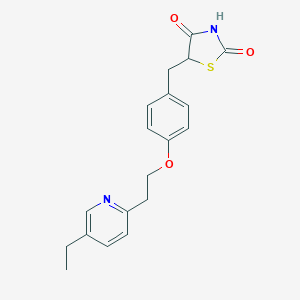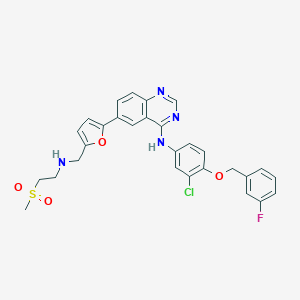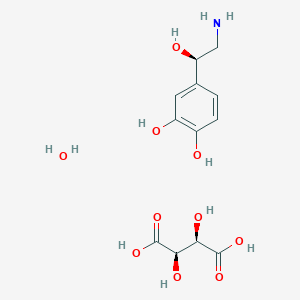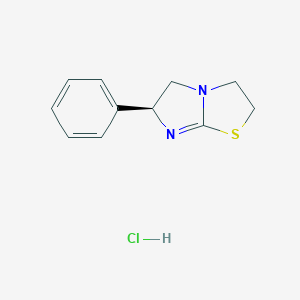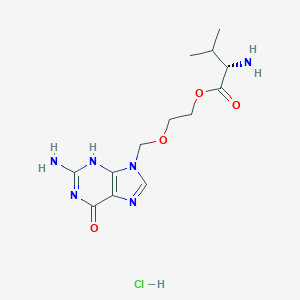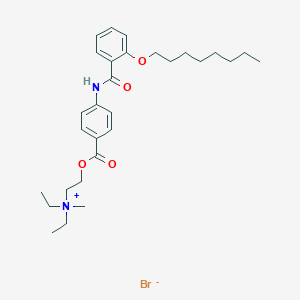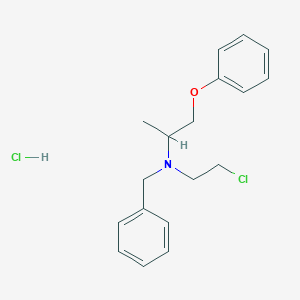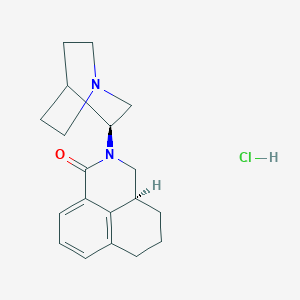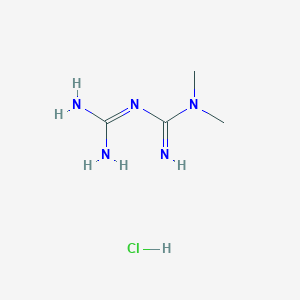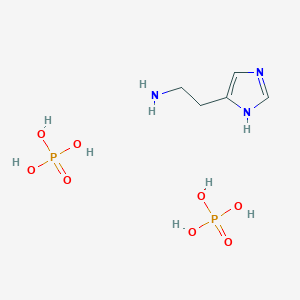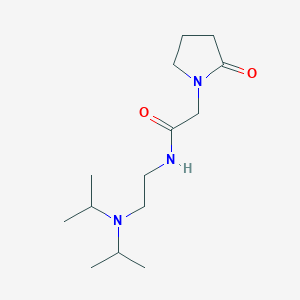
Pramiracetam
Descripción general
Descripción
Pramiracetam es un agente nootrópico que pertenece a la familia de fármacos racetam. Es un derivado sintético del piracetam, el primer nootrópico creado en laboratorio, pero es significativamente más potente. This compound se comercializa bajo varios nombres comerciales, incluyendo Pramistar, Neupramir y Remen. Se utiliza principalmente para mejorar la memoria y las funciones cognitivas, particularmente en individuos con demencias neurodegenerativas y vasculares .
Aplicaciones Científicas De Investigación
El pramiracetam se ha estudiado ampliamente por su potencial en diversos campos científicos:
Química: El this compound se utiliza como compuesto modelo en el estudio de la síntesis y las reacciones de los derivados racetam.
Biología: Se utiliza para investigar los efectos de los nootrópicos en la función cerebral y los sistemas de neurotransmisores.
Medicina: El this compound se utiliza para tratar el deterioro cognitivo, la pérdida de memoria y enfermedades neurodegenerativas como la enfermedad de Alzheimer y la demencia
Industria: El this compound se utiliza en el desarrollo de potenciadores cognitivos y agentes neuroprotectores.
Mecanismo De Acción
El pramiracetam ejerce sus efectos mejorando la captación de colina de alta afinidad, que es un precursor de la acetilcolina. La acetilcolina es un neurotransmisor implicado en la memoria y el aprendizaje. El this compound también aumenta la actividad de la aldosterona en el cerebro, lo que mejora el tono simpático y media la respuesta de lucha o huida .
Análisis Bioquímico
Biochemical Properties
Pramiracetam is believed to indirectly affect the release of neurotransmitters, brain chemicals that transmit signals from one nerve cell to another .
Cellular Effects
This compound has been shown to improve memory in healthy elderly adults with memory loss and enhance overall cognition in young adults with memory problems . It is also suggested to optimize overall brain function and increase focus and productivity .
Molecular Mechanism
The molecular mechanism of action of this compound is not well known . It might enhance acetylcholine synthesis
Temporal Effects in Laboratory Settings
It is effective when taken acutely (1-2 hours) before cognitive testing .
Dosage Effects in Animal Models
In animal studies, this compound has shown benefits to long-term memory formation in both young and old rats . The effects of varying dosages of this compound in animal models have not been extensively studied .
Metabolic Pathways
It is suggested that this compound might enhance acetylcholine synthesis
Transport and Distribution
Information on how this compound is transported and distributed within cells and tissues is currently limited .
Subcellular Localization
The subcellular localization of this compound and its effects on activity or function are not well known
Métodos De Preparación
Rutas Sintéticas y Condiciones de Reacción
El pramiracetam se sintetiza a partir del piracetam mediante la sustitución del grupo amida por un grupo dipropan-2-ylaminoetil. La síntesis implica una reacción de condensación, disolución y filtración, redisolución y extracción, reflujo, congelación y filtración por succión . El proceso es relativamente sencillo, lo que lo hace adecuado para la producción a gran escala.
Métodos de Producción Industrial
La producción industrial del this compound implica la reacción del éster etílico de pirrolidona con N,N-diisopropiletilendiamina. Esta reacción se lleva a cabo en un sistema bifásico de tolueno-agua utilizando carbonato de sodio como catalizador. El intermedio resultante se hace reaccionar entonces con la sal sódica de pirrolidona en una solución de tolueno, seguido de calentamiento y eliminación del metanol para obtener this compound .
Análisis De Reacciones Químicas
Tipos de Reacciones
El pramiracetam se somete a diversas reacciones químicas, entre ellas:
Oxidación: El this compound se puede oxidar para formar los óxidos correspondientes.
Reducción: Las reacciones de reducción pueden convertir el this compound en sus formas reducidas.
Sustitución: El this compound puede sufrir reacciones de sustitución en las que los grupos funcionales son sustituidos por otros grupos.
Reactivos y Condiciones Comunes
Oxidación: Los agentes oxidantes comunes incluyen permanganato de potasio y peróxido de hidrógeno.
Reducción: Se utilizan agentes reductores como el hidruro de litio y aluminio y el borohidruro de sodio.
Sustitución: Las reacciones de sustitución suelen implicar reactivos como halógenos y agentes alquilantes.
Productos Principales
Los productos principales formados a partir de estas reacciones incluyen diversos derivados de this compound, como sus óxidos, formas reducidas y compuestos sustituidos.
Comparación Con Compuestos Similares
El pramiracetam forma parte de la familia racetam, que incluye varios compuestos similares:
Piracetam: El primer nootrópico, utilizado para la mejora cognitiva pero menos potente que el this compound.
Aniracetam: Conocido por sus propiedades ansiolíticas.
Oxiracetam: Utilizado por sus efectos estimulantes en el sistema nervioso central.
Fenilpiracetam: Más potente y utilizado para un rango más amplio de indicaciones.
Coluracetam: Conocido por sus efectos en la captación de colina.
Nefiracetam: Investigado por su potencial en el tratamiento de deterioros cognitivos .
El this compound es único debido a su alta potencia y mecanismo de acción específico, lo que lo convierte en un compuesto valioso en el campo de la mejora cognitiva.
Propiedades
IUPAC Name |
N-[2-[di(propan-2-yl)amino]ethyl]-2-(2-oxopyrrolidin-1-yl)acetamide | |
|---|---|---|
| Source | PubChem | |
| URL | https://pubchem.ncbi.nlm.nih.gov | |
| Description | Data deposited in or computed by PubChem | |
InChI |
InChI=1S/C14H27N3O2/c1-11(2)17(12(3)4)9-7-15-13(18)10-16-8-5-6-14(16)19/h11-12H,5-10H2,1-4H3,(H,15,18) | |
| Source | PubChem | |
| URL | https://pubchem.ncbi.nlm.nih.gov | |
| Description | Data deposited in or computed by PubChem | |
InChI Key |
ZULJGOSFKWFVRX-UHFFFAOYSA-N | |
| Source | PubChem | |
| URL | https://pubchem.ncbi.nlm.nih.gov | |
| Description | Data deposited in or computed by PubChem | |
Canonical SMILES |
CC(C)N(CCNC(=O)CN1CCCC1=O)C(C)C | |
| Source | PubChem | |
| URL | https://pubchem.ncbi.nlm.nih.gov | |
| Description | Data deposited in or computed by PubChem | |
Molecular Formula |
C14H27N3O2 | |
| Source | PubChem | |
| URL | https://pubchem.ncbi.nlm.nih.gov | |
| Description | Data deposited in or computed by PubChem | |
Related CAS |
72869-16-0 (sulfate) | |
| Record name | Pramiracetam [INN] | |
| Source | ChemIDplus | |
| URL | https://pubchem.ncbi.nlm.nih.gov/substance/?source=chemidplus&sourceid=0068497621 | |
| Description | ChemIDplus is a free, web search system that provides access to the structure and nomenclature authority files used for the identification of chemical substances cited in National Library of Medicine (NLM) databases, including the TOXNET system. | |
DSSTOX Substance ID |
DTXSID60218604 | |
| Record name | Pramiracetam | |
| Source | EPA DSSTox | |
| URL | https://comptox.epa.gov/dashboard/DTXSID60218604 | |
| Description | DSSTox provides a high quality public chemistry resource for supporting improved predictive toxicology. | |
Molecular Weight |
269.38 g/mol | |
| Source | PubChem | |
| URL | https://pubchem.ncbi.nlm.nih.gov | |
| Description | Data deposited in or computed by PubChem | |
CAS No. |
68497-62-1 | |
| Record name | Pramiracetam | |
| Source | CAS Common Chemistry | |
| URL | https://commonchemistry.cas.org/detail?cas_rn=68497-62-1 | |
| Description | CAS Common Chemistry is an open community resource for accessing chemical information. Nearly 500,000 chemical substances from CAS REGISTRY cover areas of community interest, including common and frequently regulated chemicals, and those relevant to high school and undergraduate chemistry classes. This chemical information, curated by our expert scientists, is provided in alignment with our mission as a division of the American Chemical Society. | |
| Explanation | The data from CAS Common Chemistry is provided under a CC-BY-NC 4.0 license, unless otherwise stated. | |
| Record name | Pramiracetam [INN] | |
| Source | ChemIDplus | |
| URL | https://pubchem.ncbi.nlm.nih.gov/substance/?source=chemidplus&sourceid=0068497621 | |
| Description | ChemIDplus is a free, web search system that provides access to the structure and nomenclature authority files used for the identification of chemical substances cited in National Library of Medicine (NLM) databases, including the TOXNET system. | |
| Record name | Pramiracetam | |
| Source | DrugBank | |
| URL | https://www.drugbank.ca/drugs/DB13247 | |
| Description | The DrugBank database is a unique bioinformatics and cheminformatics resource that combines detailed drug (i.e. chemical, pharmacological and pharmaceutical) data with comprehensive drug target (i.e. sequence, structure, and pathway) information. | |
| Explanation | Creative Common's Attribution-NonCommercial 4.0 International License (http://creativecommons.org/licenses/by-nc/4.0/legalcode) | |
| Record name | Pramiracetam | |
| Source | EPA DSSTox | |
| URL | https://comptox.epa.gov/dashboard/DTXSID60218604 | |
| Description | DSSTox provides a high quality public chemistry resource for supporting improved predictive toxicology. | |
| Record name | 68497-62-1 | |
| Source | European Chemicals Agency (ECHA) | |
| URL | https://echa.europa.eu/information-on-chemicals | |
| Description | The European Chemicals Agency (ECHA) is an agency of the European Union which is the driving force among regulatory authorities in implementing the EU's groundbreaking chemicals legislation for the benefit of human health and the environment as well as for innovation and competitiveness. | |
| Explanation | Use of the information, documents and data from the ECHA website is subject to the terms and conditions of this Legal Notice, and subject to other binding limitations provided for under applicable law, the information, documents and data made available on the ECHA website may be reproduced, distributed and/or used, totally or in part, for non-commercial purposes provided that ECHA is acknowledged as the source: "Source: European Chemicals Agency, http://echa.europa.eu/". Such acknowledgement must be included in each copy of the material. ECHA permits and encourages organisations and individuals to create links to the ECHA website under the following cumulative conditions: Links can only be made to webpages that provide a link to the Legal Notice page. | |
| Record name | PRAMIRACETAM | |
| Source | FDA Global Substance Registration System (GSRS) | |
| URL | https://gsrs.ncats.nih.gov/ginas/app/beta/substances/4449F8I3LE | |
| Description | The FDA Global Substance Registration System (GSRS) enables the efficient and accurate exchange of information on what substances are in regulated products. Instead of relying on names, which vary across regulatory domains, countries, and regions, the GSRS knowledge base makes it possible for substances to be defined by standardized, scientific descriptions. | |
| Explanation | Unless otherwise noted, the contents of the FDA website (www.fda.gov), both text and graphics, are not copyrighted. They are in the public domain and may be republished, reprinted and otherwise used freely by anyone without the need to obtain permission from FDA. Credit to the U.S. Food and Drug Administration as the source is appreciated but not required. | |
Synthesis routes and methods I
Procedure details




Synthesis routes and methods II
Procedure details




Retrosynthesis Analysis
AI-Powered Synthesis Planning: Our tool employs the Template_relevance Pistachio, Template_relevance Bkms_metabolic, Template_relevance Pistachio_ringbreaker, Template_relevance Reaxys, Template_relevance Reaxys_biocatalysis model, leveraging a vast database of chemical reactions to predict feasible synthetic routes.
One-Step Synthesis Focus: Specifically designed for one-step synthesis, it provides concise and direct routes for your target compounds, streamlining the synthesis process.
Accurate Predictions: Utilizing the extensive PISTACHIO, BKMS_METABOLIC, PISTACHIO_RINGBREAKER, REAXYS, REAXYS_BIOCATALYSIS database, our tool offers high-accuracy predictions, reflecting the latest in chemical research and data.
Strategy Settings
| Precursor scoring | Relevance Heuristic |
|---|---|
| Min. plausibility | 0.01 |
| Model | Template_relevance |
| Template Set | Pistachio/Bkms_metabolic/Pistachio_ringbreaker/Reaxys/Reaxys_biocatalysis |
| Top-N result to add to graph | 6 |
Feasible Synthetic Routes
Descargo de responsabilidad e información sobre productos de investigación in vitro
Tenga en cuenta que todos los artículos e información de productos presentados en BenchChem están destinados únicamente con fines informativos. Los productos disponibles para la compra en BenchChem están diseñados específicamente para estudios in vitro, que se realizan fuera de organismos vivos. Los estudios in vitro, derivados del término latino "in vidrio", involucran experimentos realizados en entornos de laboratorio controlados utilizando células o tejidos. Es importante tener en cuenta que estos productos no se clasifican como medicamentos y no han recibido la aprobación de la FDA para la prevención, tratamiento o cura de ninguna condición médica, dolencia o enfermedad. Debemos enfatizar que cualquier forma de introducción corporal de estos productos en humanos o animales está estrictamente prohibida por ley. Es esencial adherirse a estas pautas para garantizar el cumplimiento de los estándares legales y éticos en la investigación y experimentación.
